SBOA400 July 2020 – MONTH TMCS1100 , TMCS1100-Q1 , TMCS1101 , TMCS1101-Q1 , TMCS1107 , TMCS1107-Q1 , TMCS1108 , TMCS1108-Q1
2 Probes and Measurement Setup
To verify the thermal performance of the TMCS1100 for a particular system design, reliable and repeatable measurements must be taken. This section provides a detailed description of several of the key variables to be aware of when preparing the test setup when using a thermocouple. Following the detailed discussion of each key variable is a summary of best practices for quick reference.
Sensor
Measuring temperature can be achieved through a few different methods that include IR camera, a fluor-optic probe, a thermocouple, temperature sensor IC, thermistor, RTD, and IR gun. Each method has its own set of advantages and challenges. For this particular app-note, K type thermocouples were used as these are standardized, ubiquitous, relatively linear, can be placed inside a 125°C oven chamber, and can easily measure up to 150°C. Other standardized thermocouples such as types E, J, N, T, R/S, and B could also be used as these also are well characterized and can easily be analyzed with thermocouple interface modules, like the USB-TC01 offered by National Instruments. Such modules allow for a simple interface that can be automated with a computer. Additionally, such modules provide a cold junction compensation circuit, which is a good alternative to soaking the cold junction of a thermocouple in ice water.
Following the selection of a thermocouple sensor, test setup details to observe include sensor location, secure sensor placement, sensor contact, thermal mass, thermal lag, and ambient temperature.
Sensor Location
Probe location matters, as the part does not exhibit a uniform heat profile when the device is powered, and even less so when current is passed through the leadframe. Non-uniform heat profiles can be observed in simulations of the TMCS1100 case thermal profile, junction thermal profile, and leadframe thermal profile. In the leadframe thermal profile, you can see that for a given current the temperature is highest in the central bend, where the current encounters the greatest resistance. From this point, heat has multiple paths it can flow through the leadframe, case, and IC die to the ambient environment. Depending upon thermal resistance between the bend and the probe point as well as external heat sources/sinks, significantly different temperatures can be observed. These heat profile simulations correspond to a TMCS1100 subjected to 20 A at 25°C ambient on the TMCS1100EVM. While these models are ideal and neglect several variables of influence that will be present in a bench setup, these still provide some insight into what the relative heat flow will be through the device. These heat plots indicate the difference in temperature that might be observed according to where the probe is placed.
In terms of uniformity, the die (or junction) has the most uniform profile, yet yields the challenge of not being exposed for direct measurement. The next most uniform heat gradient, based on the amount of change in relation to surface area, is the top of the case. The last and largest heat gradient is exhibited on the leadframe. As the leadframe has the greatest variation over a significantly smaller exposed surface area, we do not recommend probing on the leadframe pin due to the precision required for repeatability in measurement. Additionally, if temperature tests are performed on the end application board, there could be complications with the thermocouple probe being at the leadframe pin voltage potential. Consequently, we recommend using a case temperature reading after an initial correlation with junction temperature.
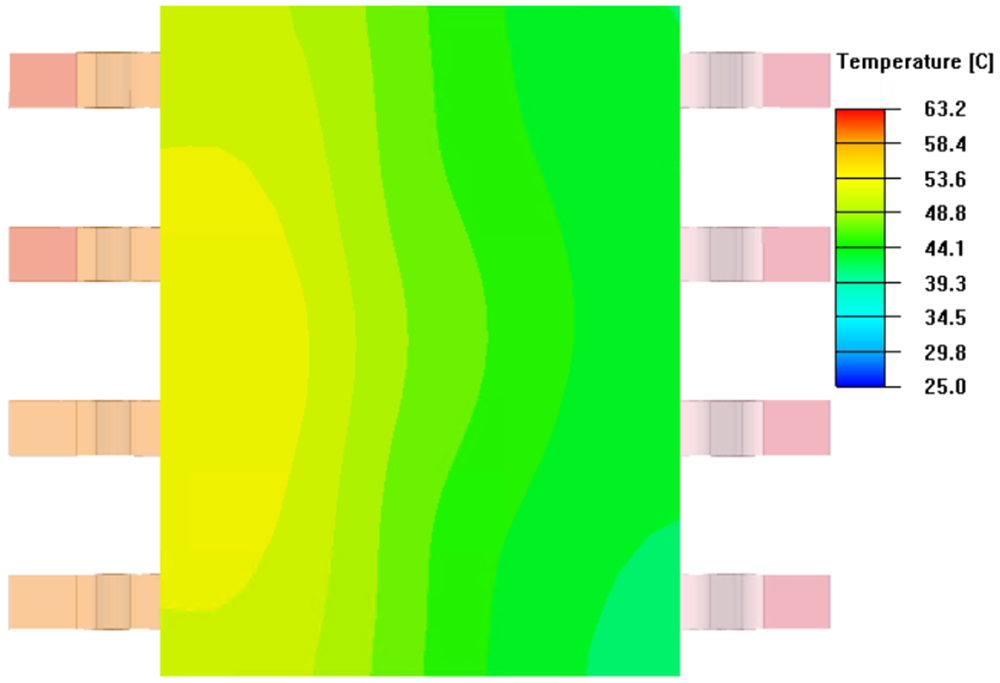 Figure 2-1 Case Thermal Profile
Figure 2-1 Case Thermal Profile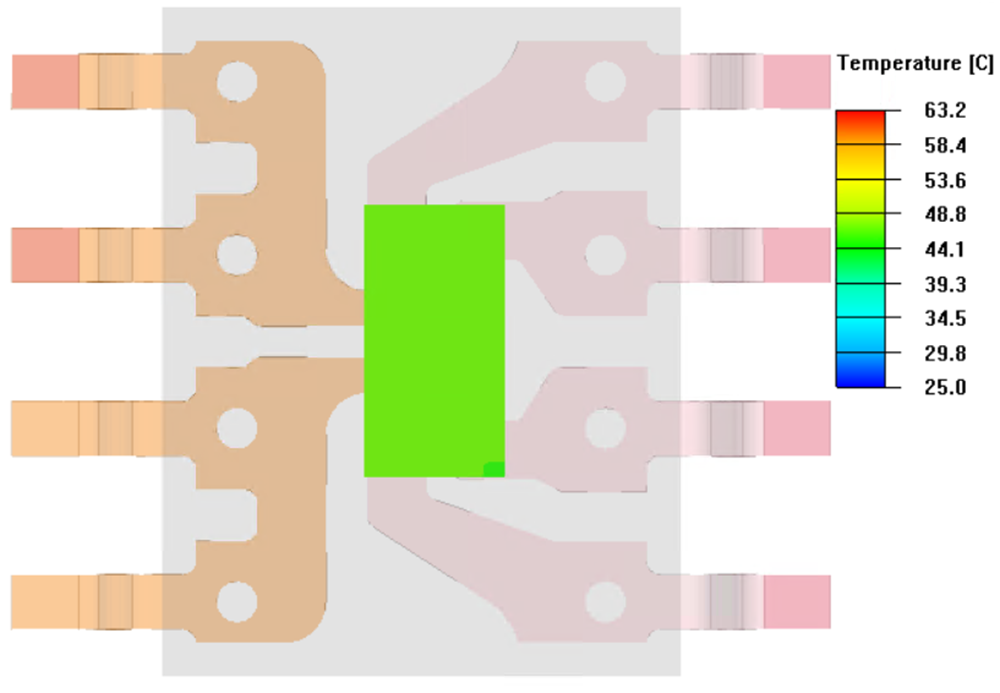 Figure 2-2 Junction Thermal Profile
Figure 2-2 Junction Thermal Profile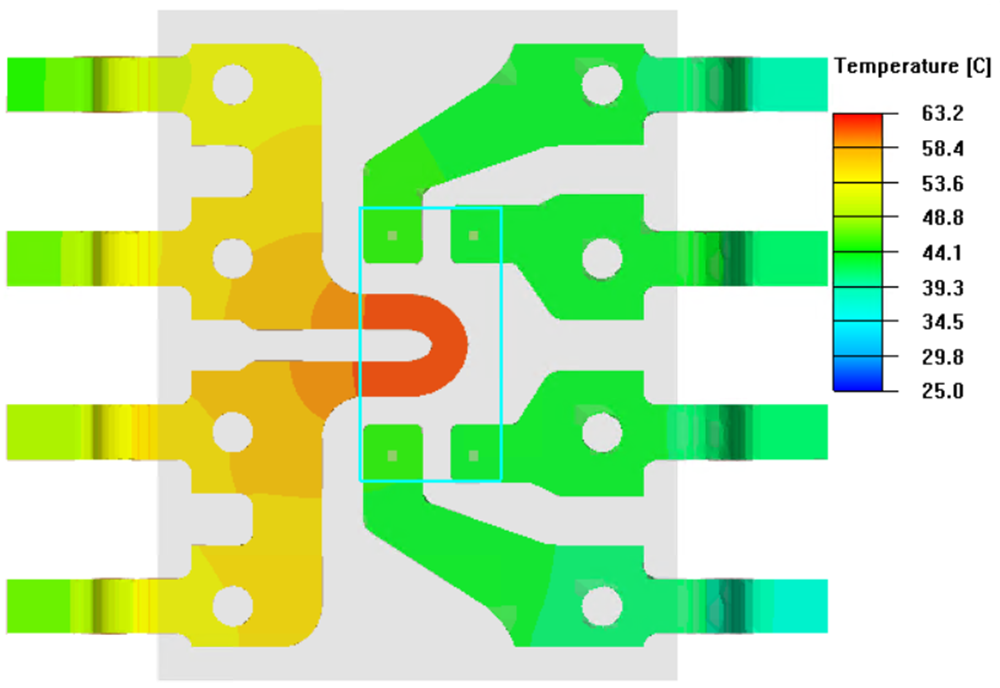 Figure 2-3 Leadframe Thermal Profile
Figure 2-3 Leadframe Thermal Profile Figure 2-4 Leadframe Side Thermal
Profile
Figure 2-4 Leadframe Side Thermal
ProfileSecure Sensor Placement
Since within a generic probe region there can be a substantial thermal gradient, it is important to have repeatable, secure placement. As such, the setup used for this application report utilized a 3D printed thermocouple fixture to restrict the freedom of motion and guide the thermocouple toward the desired probe location. Additionally, this fixture provided force on the thermocouple wire such that the thermocouple maintained good contact with the surface and eliminated probe movement from board handling. When sweeping the system across temperatures in an oven, careful consideration should be given to the material used for probe fixture, as fixture melting point and thermal expansion of test setup materials can displace the probe. For some tests performed in this application report, devices were subjected to 125°C ambient. Some standard 3D printer materials have a glass transition temperature below that, which can lead to their shape changing and the measurement probe moving. Consequently, a nylon fixture was used for the 125°C ambient measurements.
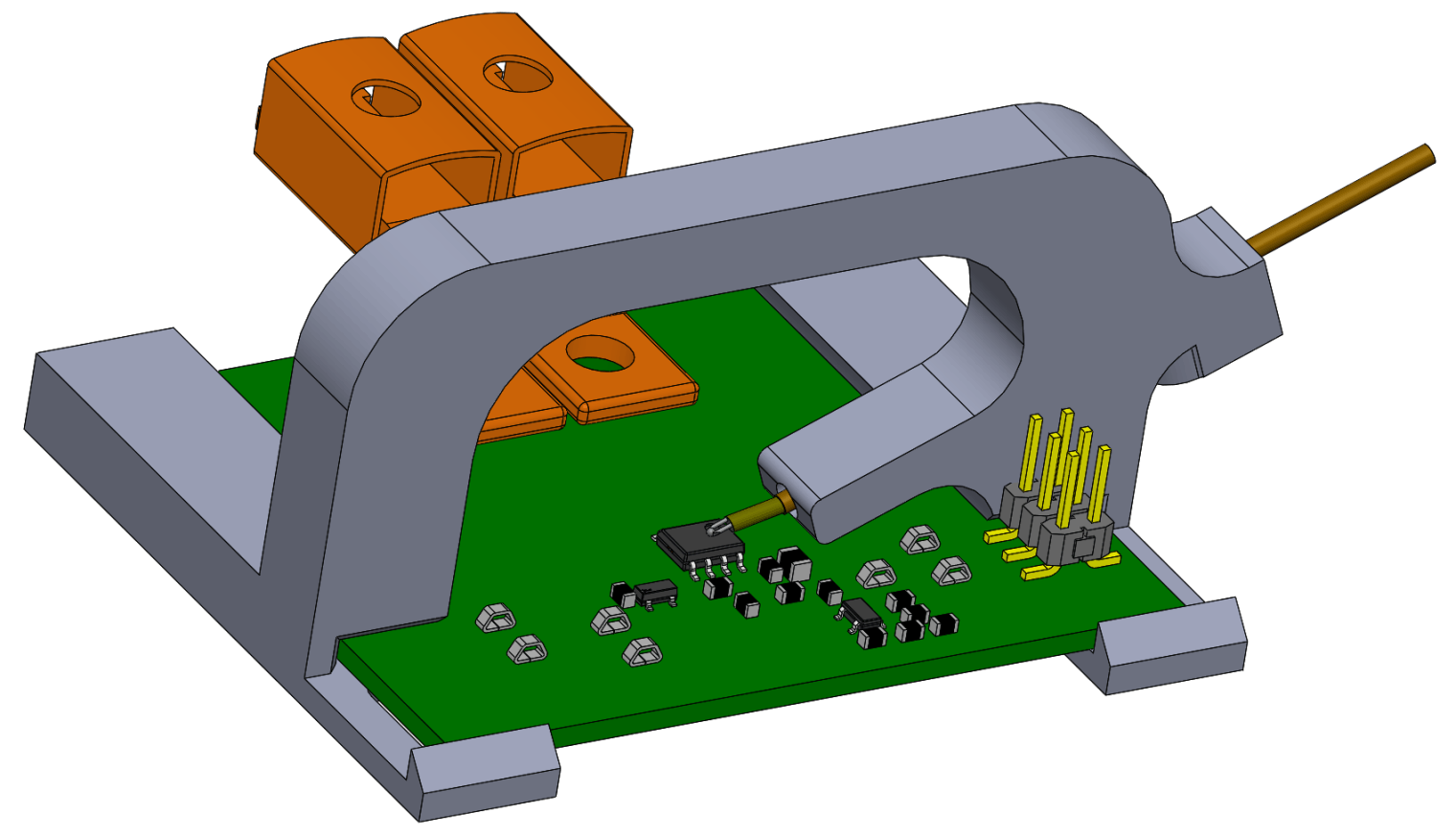 Figure 2-5 Thermocouple Fixture
Figure 2-5 Thermocouple Fixture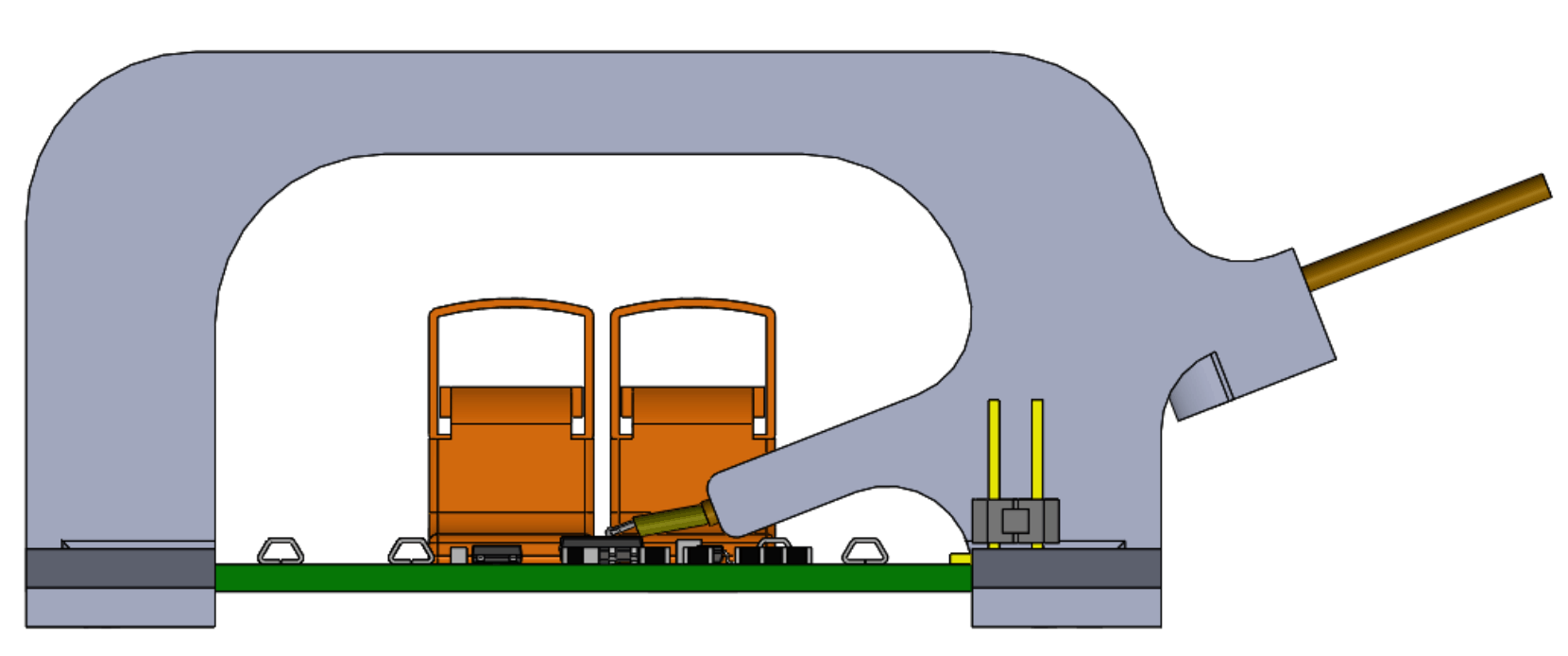 Figure 2-6 Thermocouple Fixture - Front
Figure 2-6 Thermocouple Fixture - Front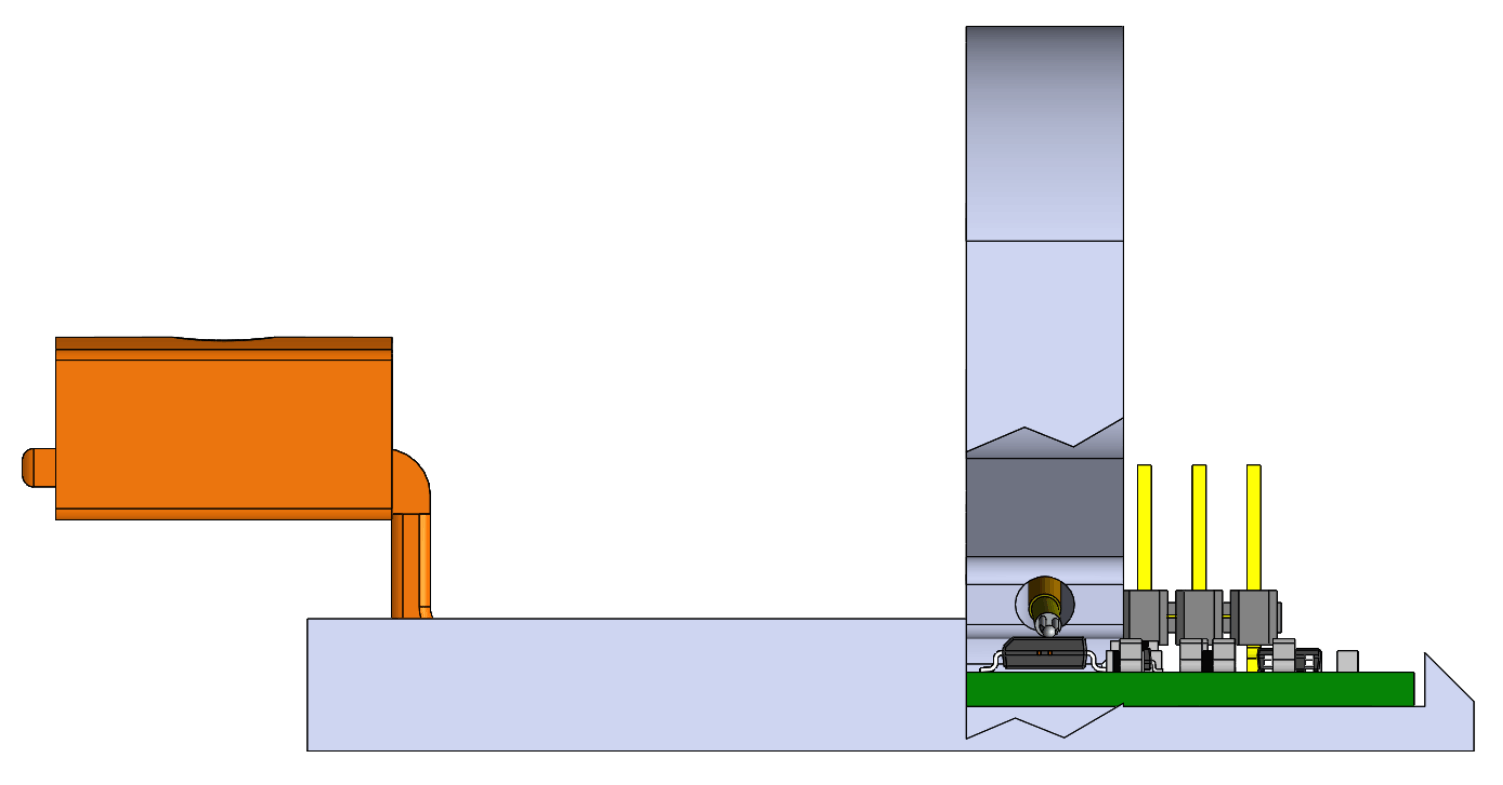 Figure 2-7 Thermocouple Fixture - Left
Figure 2-7 Thermocouple Fixture - Left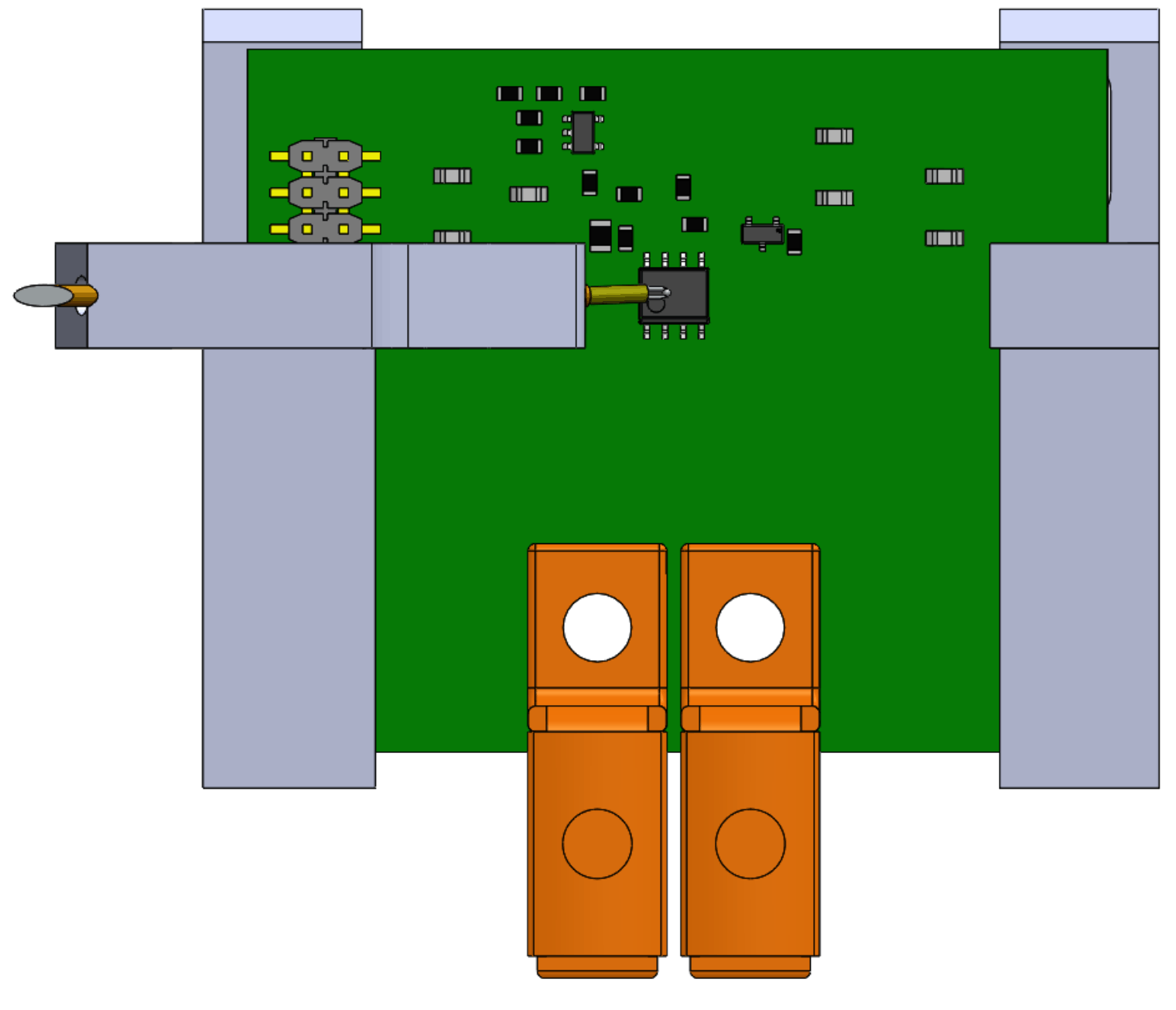 Figure 2-8 Thermocouple Fixture - Top
Figure 2-8 Thermocouple Fixture - TopSensor Contact
Just as crucial as probe location and secure placement is probe surface contact. If improperly addressed, bad surface contact can lead to unwanted thermal resistance between the probe and measurement target location. Along with forcing the probe onto the case, we recommend using thermal paste to provide a good thermal conductive bridge between the surface of the thermocouple and the surface of the sense location. Ideally, the thermal paste quantity should not extend much beyond the circumference of the thermocouple joint as shown in the Thermal Paste Diagram, as the thermal paste can influence thermal performance. We recommend using a micro-syringe to provide a controlled quantity to the sense location.
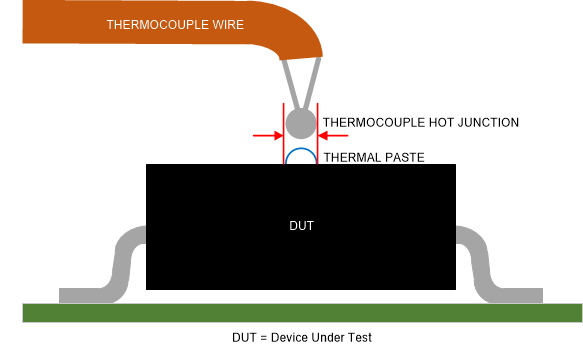 Figure 2-9 Thermal Paste Diagram
Figure 2-9 Thermal Paste DiagramThermal Mass
Part of the reason thermal paste should be minimized is that it provides some thermal mass. Any thermal mass connected to the package can influence the thermal behavior. Large globs of thermal paste provide a thermally conductive mass with more surface area exposed to air flow that increases convective heat loss. Aside from thermal paste, large masses like a thermocouple lead or load input that channel out of the test chamber into a colder ambient environment sink more heat away, especially if the mass has a good thermally conductive interface to the device. Using Equation 1 and Figure 2-10, the heat conducted through the channel can be extrapolated. Lower gauge wire corresponding to thicker wire has a larger cross-sectional area. According to the equation, larger cross-sectional area increases Q, the amount of heat flowing. Also according to the equation, a large temperature delta between the thermocouple hot junction and some other point of the thermocouple, such as outside of an oven, will increase heat flow, especially as the distance between those two points is shortened. Therefore, the size of the thermocouple leads and junction should be minimized and the length of probe wire in the controlled temperature chamber should be maximized.

where
- Q is the amount of heat conducting through the channel
- Δt is the time interval of interest for a given conduction channel
- A is the cross-sectional area of the channel
- ΔT is the temperature difference between both ends of the channel
- Δx is the length of the channel.
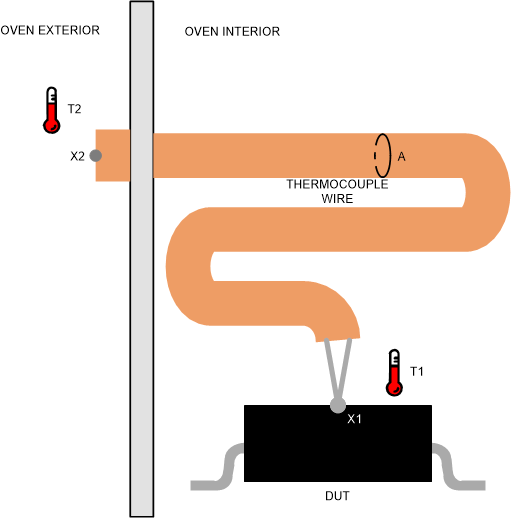 Figure 2-10 Thermocouple Thermal Conduction
Coefficients
Figure 2-10 Thermocouple Thermal Conduction
CoefficientsThermal Lag
After setting up the probes for measurement, there is still a run-time issue to consider, which can be broadly related to thermal lag and thermal equilibrium. Relative initial temperature, external heat sources, distance, run-time, and thermal resistance between the heat source and the probe location will all influence what temperature is observed at a particular probe location. In our measurements, we typically step from no load to several amps of current in a controlled ambient environment with no significant adjacent heat sources. In this scenario, probes placed on the device have exuded an initial steep rise in temperature that then gradually levels off as the rate of heat entering that location balances with the rate of heat leaving that location. When the temperature no longer increases after the current has been set, that location has reached thermal equilibrium. Figure 2-11 illustrates how the temperature lags behind the current and can take a significant amount of time to reach thermal equilibrium. With good ambient regulation, the tests in this application report indicate thermal equilibrium may be reached in about three minutes for a continuous current load.
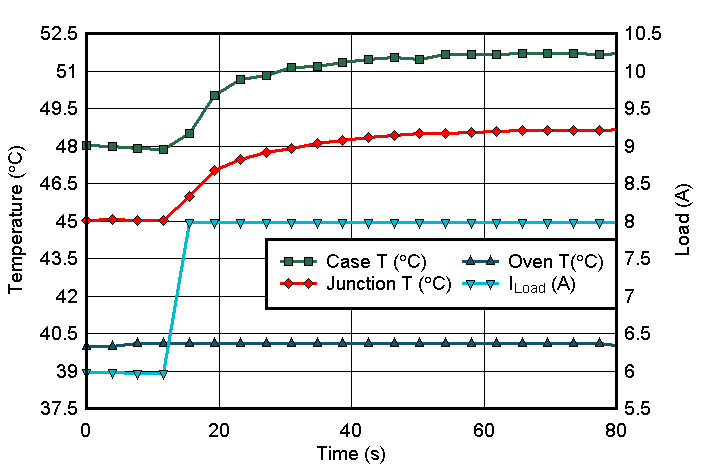 Figure 2-11 Temperature and Load vs Time
Figure 2-11 Temperature and Load vs TimeAmbient Temperature
As alluded to in the thermal lag section, ambient temperature can influence results if not tightly monitored and regulated. This can be readily observed at lower currents and lower ambient temperatures. If the test board is left in a loosely temperature controlled chamber like a typical lab, then measurements may exhibit periodic 5°C swings due to the building HVAC system. Alternatively if the device is housed in any unregulated enclosure to shield from the wind chill of lab equipment exhaust fans or the building HVAC system, ambient temperature drift within the enclosure may make the device never seem to reach thermal equilibrium. Even within a controlled chamber there is expected to be some temperature gradient in which the immediate air space surrounding the device may be at a different temperature than the oven sensor, especially on a test board involving other parts dissipating heat. We recommend having at least one ambient temperature sensor nearby when assessing device thermal performance.
Summary of Best Practices
The previous discussion on how best to set up a thermocouple for case measurements is summarized in Figure 2-12 through Figure 2-21. The left column of images illustrate bad setup examples, while the right column shows good setup examples.
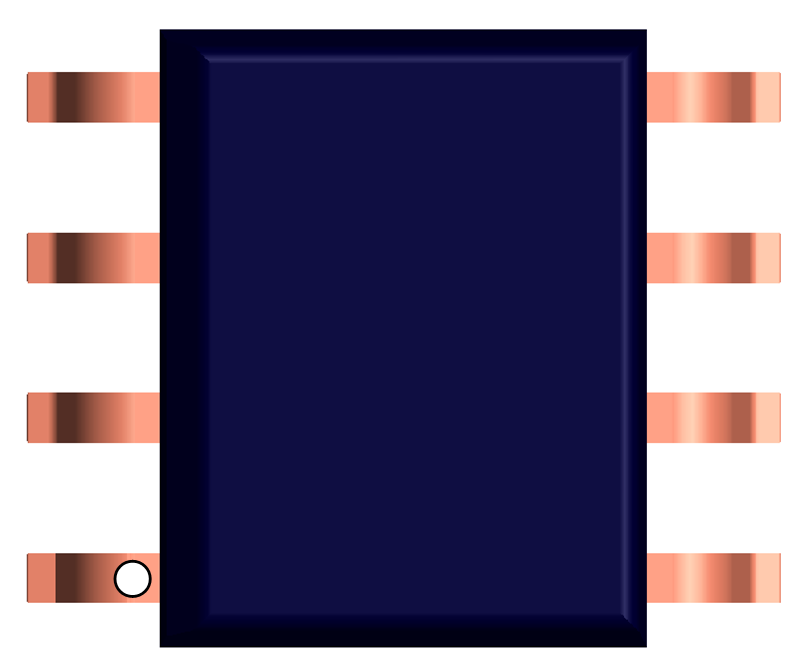 Figure 2-12 Probe on Pin
Figure 2-12 Probe on Pin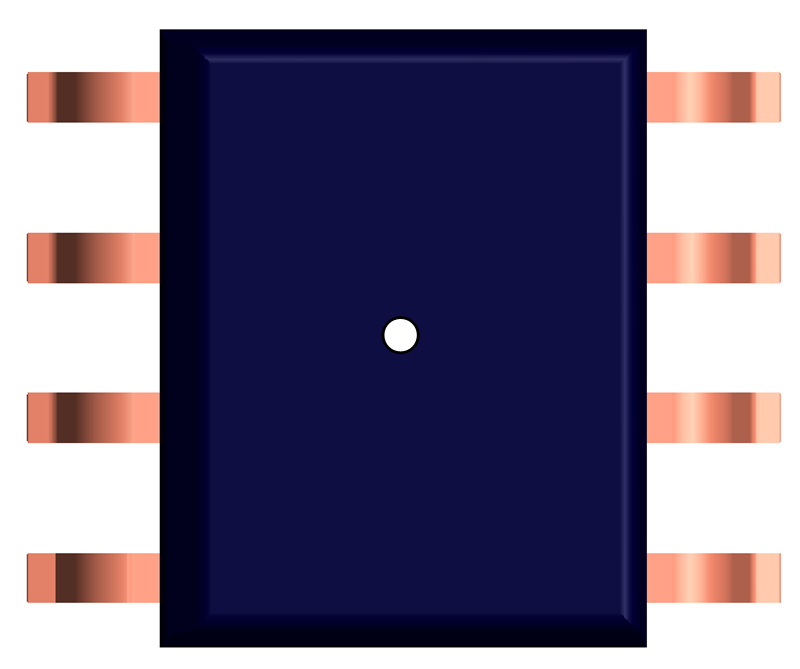 Figure 2-13 Probe on Case
Figure 2-13 Probe on Case- Probing on the case requires less precision than probing on the pin, and is therefore more repeatable.
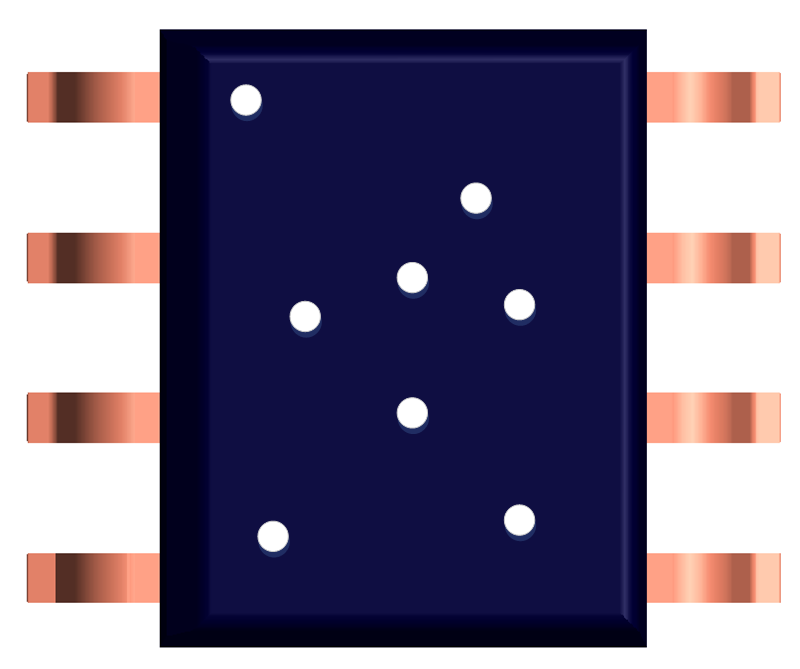 Figure 2-14 Low Precision
Figure 2-14 Low Precision Figure 2-15 High Precision
Figure 2-15 High Precision- The package does exhibit a thermal gradient, so tighter precision will provide more consistent results.
 Figure 2-16 Too Much Thermal Paste
Figure 2-16 Too Much Thermal Paste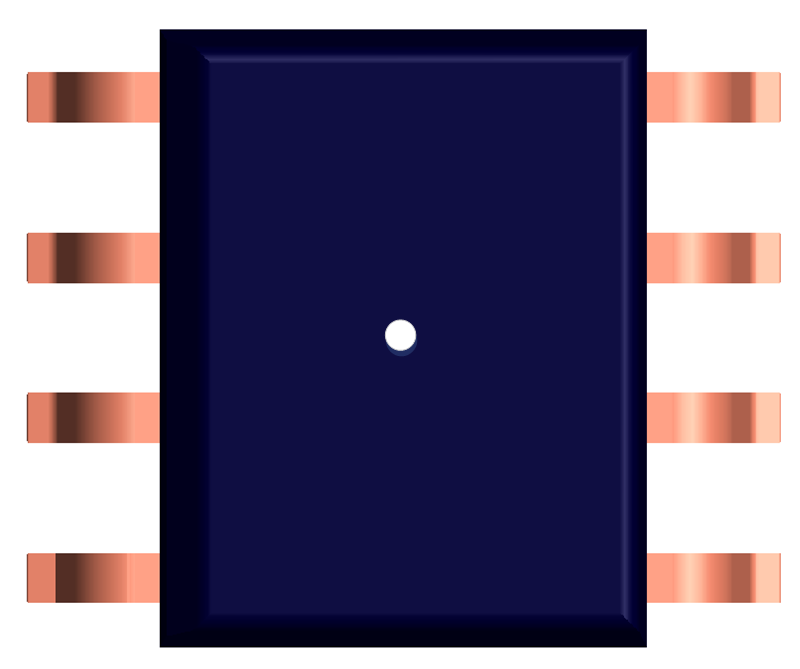 Figure 2-17 Enough Thermal Paste
Figure 2-17 Enough Thermal Paste- While thermal paste is necessary for a good connection between the case and thermocouple, it does influence the thermal behavior and should be minimized if it is not expected to be on the final manufactured board.
 Figure 2-18 Large Thermocouple
Figure 2-18 Large Thermocouple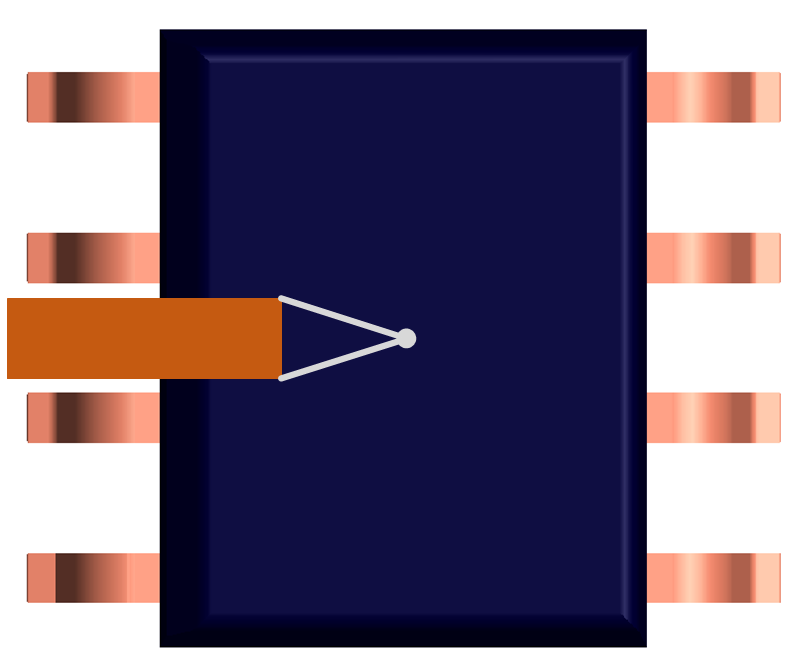 Figure 2-19 Small Thermocouple
Figure 2-19 Small Thermocouple- Smaller probes channel less heat away from the case and therefore provide a better indication of thermal performance if the probe was not present.
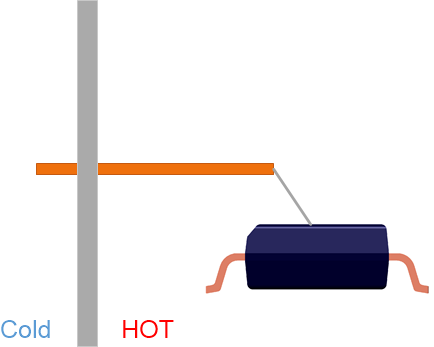 Figure 2-20 Short Lead in Chamber
Figure 2-20 Short Lead in Chamber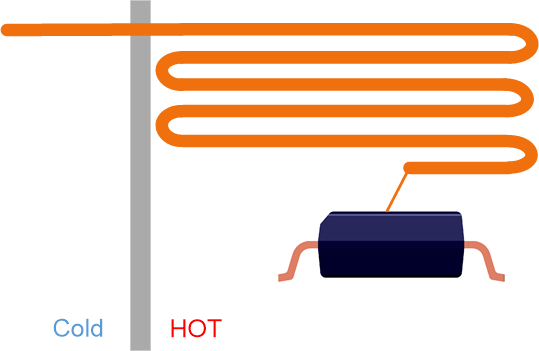 Figure 2-21 Long Lead in Chamber
Figure 2-21 Long Lead in Chamber- A longer thermocouple lead in the chamber provides more thermocouple mass at the desired ambient temperature and increases the thermal resistance thereby restricting heatflow to the colder outer chamber.